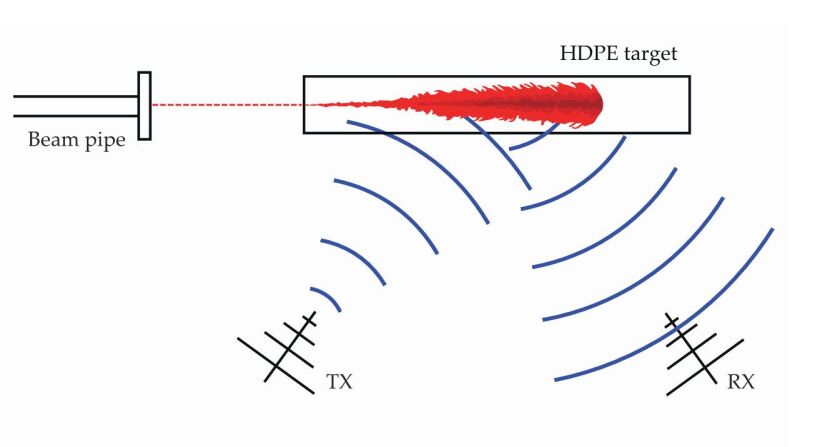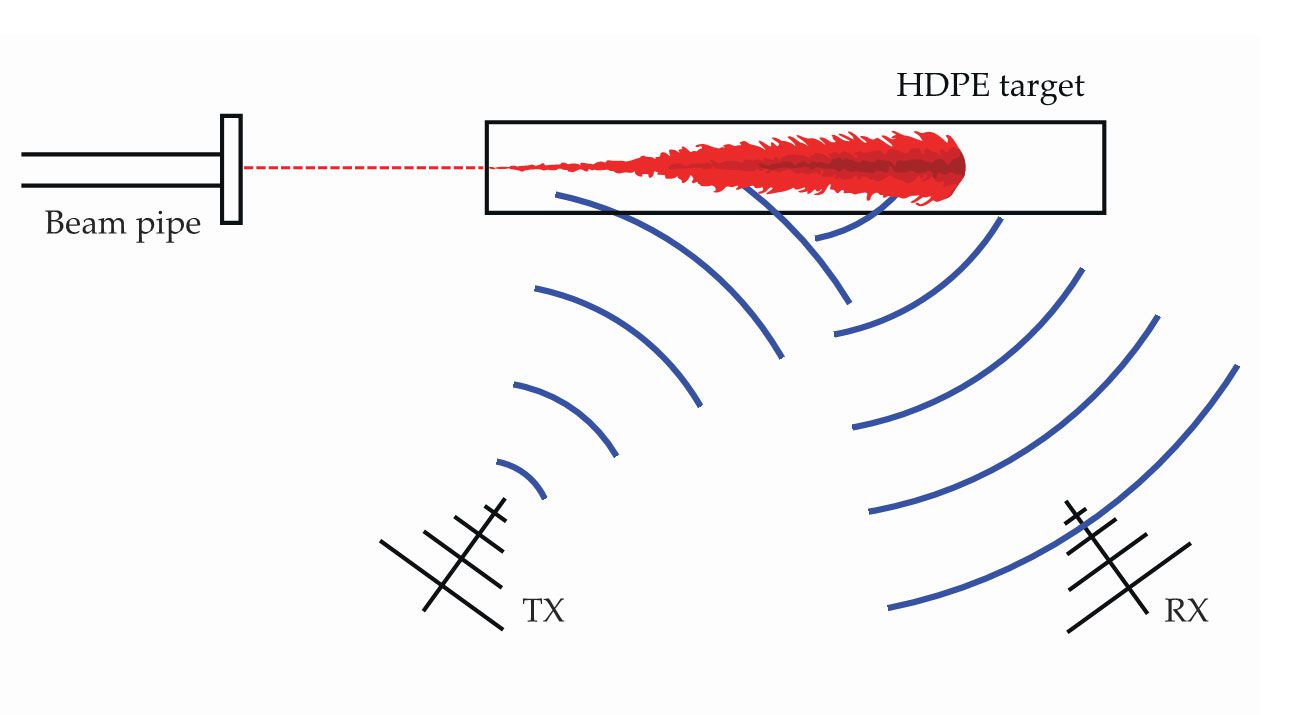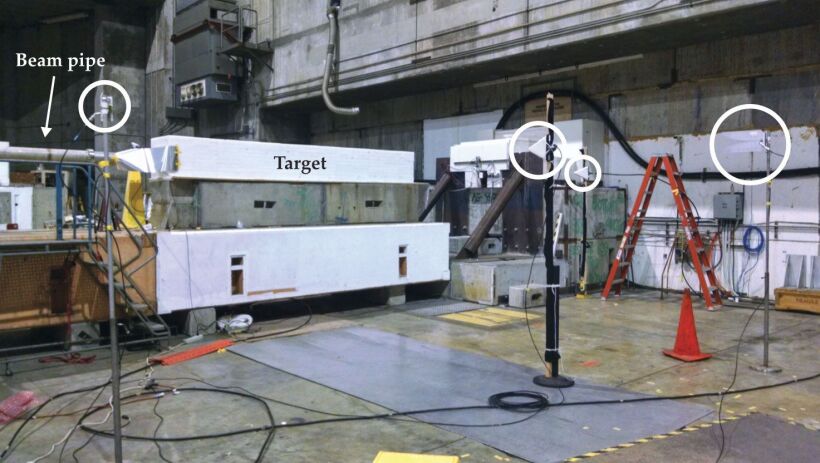Radar points the way to detecting cosmic neutrinos
DOI: 10.1063/PT.3.4467
Cosmic rays—the electrons, protons, antiparticles, and nuclei that penetrate Earth’s atmosphere—can exceed 1020 eV. Accelerating particles to such high energies requires a violent, impulsive process, such as the merger of neutron stars, the collapse of a massive star, or the rapid conversion of a supermassive black hole’s rotational energy. Ultrahigh-energy neutrinos are thought to emerge from such exotic sources (see the article by Peter Mészáros, Physics Today, October 2018, page 36
The neutrinos’ feeble interaction with matter makes them powerful messengers of new physics, but it also complicates their detection. For example, the IceCube neutrino observatory in Antarctica relies on catching the flashes of Cherenkov light from muons produced by neutrinos inside a billion tons of ice. The 1 km3 observatory requires an array of more than 5000 photomultiplier tubes because the flux of ultrahigh-energy neutrinos is so small and plummets with neutrino energy. The highest-energy neutrinos IceCube ever measured are a few peta-electron volts (1 PeV = 1015 eV).
How energetic is such a neutrino? One joule is about 1019 eV, roughly equivalent to the energy of a slow-pitched baseball. At one-thousandth of a joule, 10 PeV is the kinetic energy equivalent of a honeybee in flight. But whereas the honeybee’s energy is distributed over some 1023 atoms, extreme astrophysical events concentrate the energy in a single cosmic neutrino. To have much chance of catching one, you need to increase the search volume or change methods.
An international collaboration led by Steven Prohira (a postdoctoral fellow at the Ohio State University) now reports 1 a proof-of-concept measurement of an old proposal: using radar to detect the interaction of a neutrino in ice. The approach requires no new technology and could scan potentially enormous volumes inexpensively. More importantly, it could detect neutrinos in an energy window that is a blind spot to existing methods.
Radio waves
In 1962 Gurgen Askaryan realized that air showers, or cascades, of relativistic electrons, muons, and other particles that beget Cherenkov light contain a negative-charge excess of about 10‒20%.
2
The charge asymmetry generates coherent radio waves, whose power scales with the square of the primary particle’s energy. With that scaling, the RF signal should be most intense at ultrahigh energies. The ANITA collaboration’s experiment—made of an array of radio antennas hanging from a helium balloon (see Physics Today, December 2010, page 22
Twenty years before Askaryan’s work, Patrick Blackett and Bernard Lovell considered another signature of cascades—although at the time the two researchers had cosmic-ray-induced cascades in mind, not neutrino-induced ones. As a cascade travels through the atmosphere, it ionizes oxygen and nitrogen atoms and leaves a plasma trail of quasi-stationary electrons. Blackett and Lovell calculated that the ionization trail should be observable when radio waves are bounced off it. 3 But despite decades of attempts, no one has ever been able to capture either a cosmic-ray- or neutrino-triggered event that way.
As Krijn de Vries (Vrije University Brussels) and coworkers realized just a few years ago, 4 the ionization trail in air is too dilute to robustly reflect a signal. But they calculated that a cascade through ice, whose density exceeds that of air by a factor of 1000, produces a far denser plasma trail of electrons in its wake, about 10 m long and 10 cm wide. Prohira, de Vries, and their colleagues now report 1 the first convincing measurements of radar reflections from the ionization trail of high-energy particles in a transparent solid.
Electrons stand in for neutrinos
Prohira and his coworkers were not looking for neutrino interactions. Their experiment at SLAC was designed to mimic a neutrino-triggered cascade by using electrons as a proxy for neutrinos and high-density polyethylene (HDPE) as a proxy for ice. Figure
Figure 1.

Radar echoes in artificial ice. Electron bunches shot into high-density polyethylene (HDPE) create a cascade of relativistic particles that mimic those produced in ice by cosmic neutrinos. At the same time, radio waves from a nearby transmitter (TX) reflect from an ionized trail in the cascade’s wake and are detected by an antenna (RX). (Adapted from ref.

Ice is nearly transparent to radio waves. Whereas Cherenkov light travels only about just 200 m in ice, radio waves travel an order of magnitude farther. Transmitting and receiving antennas may thus be spaced much farther apart than IceCube’s photomultiplier tubes.
Unlike IceCube, ANITA, and other passive-monitoring experiments, radar is an active system. Says de Vries, “Radar provides tremendous control over all our experimental parameters. The signals we receive largely depend on what we send.” The transmission power is one adjustable knob: The higher the power, the brighter the reflection. And above a critical primary-particle energy of about 10 PeV, the cloud of free electrons produced in its wake is dense enough to reflect a 0.1–1 GHz radar signal coherently. All the free reflecting electrons radiate in phase.
Transmission frequency also matters for another reason. The ionization trail in ice lives just a few nanoseconds before the free electrons reattach to nearby water molecules. To capture an electron’s oscillation before it dies, the transmission frequency must be on the gigahertz scale.
Perhaps radar echo’s most advantageous feature is its peak energy sensitivity, which is in the 10- to 100-PeV window, a blind spot for other neutrino-detection methods. Those energies are above what IceCube can efficiently resolve given its low volume, and they are below the limits of balloon-borne, satellite-borne, and some in-ice experiments.
Improving signal to noise
In the new experiment, radio noise turned out to be two orders of magnitude higher in amplitude than the expected signal. The noise was largely from “transition radiation,” produced when a charged particle crosses the interface between materials having different indices of refraction—in this case, from the vacuum of the beam chamber into the air of the lab or into the polyethylene slab. Transition radiation won’t be a problem when researchers eventually look for ionization trails from neutrino-induced cascades. In nature, those cascades take place inside the ice. But in the proof-of-concept experiment, the researchers had to address the transition radiation. Fortunately, that RF noise was similar from pulse to pulse.
To extract persuasive evidence of a cascade reflection, the researchers filtered out of their data the transition radiation and other noise—Askaryan RF fields, telecommunication signals, and reflections from concrete and metal features in the SLAC station, shown in figure
Figure 2.

The experiment at SLAC. Electrons exit the beam pipe (far left) and enter the 4-m-long polyethylene target, surrounded by transmitter and receiver antennas (circled). Second from left is the transmitter; the others are receivers. (Adapted from ref.

Prohira and his colleagues next want to repeat the experiment on a high-altitude ice sheet in Antarctica. It’s radio quiet there—though even the passage of wind generates residual RF hum—and the altitude increases the likelihood that a cosmic-ray-induced cascade will make it into the ice; the ionization trail will come from that cascade. Antennas just below the surface would transmit radar and pick up reflected signals.
After that in-nature test the researchers will turn their attention to neutrino-induced cascades.
References
1. S. Prohira et al., Phys. Rev. Lett. 124, 091101 (2020). https://doi.org/10.1103/PhysRevLett.124.091101
2. G. A. Askaryan, Sov. Phys. JETP 14, 441 (1962).
3. P. M. S. Blackett, A. C. B. Lovell, Proc. R. Soc. London A 177, 183 (1941). https://doi.org/10.1098/rspa.1941.0003
4. K. D. de Vries, K. Hanson, T. Meures, Astropart. Phys. 60, 25 (2015). https://doi.org/10.1016/j.astropartphys.2014.05.009
5. S. Prohira et al., Phys. Rev. D 100, 072003 (2019). https://doi.org/10.1103/PhysRevD.100.072003
